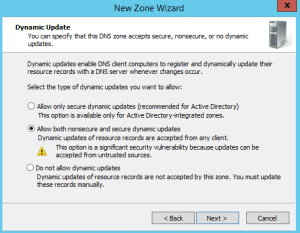How to Configure AD Integrated DNS Zone- Windows Server 2012 R2
How to Configure AD Integrated DNS zone- Windows Server 2012 R2
Steps for Configure Active Directory Integrated DNS zone in Windows Server 2012 R2.
In an old post, we already talked about the steps to install DNS in Windows Server 2012 r2 and we also learned the steps to configure forward lookup zone. In this article, we’ll talk about the steps to configure AD Integrated DNS zone in Server 2012 R2. As we know that Domain Name System is used for name resolution, it resolves the host name to IP address and IP address to host name.
In AD Integrated DNS zone, each server replicates the data with other DNS servers in a domain.
Forward lookup zone is used to resolve the host name to IP address and reverse lookup zone is used to resolve IP address to host name.
1.To configure AD Integrated Zone. click on Start button, select the down arrow and select DNS. This would open DNS manager.
2. Right-click Forward lookup zone and select “New Zone”.
3. On the “Welcome to new zone wizard”, click on next to continue.
4. In the “Zone type” window, select the type of zone that you want to use. For this practical we’ll use AD Integrated. Check on Store the zone in Active Directory to make it AD Integrated zone. This option will only be available on Domain Controller. Click on next to continue.
Types of Zones:
a) AD Integrated: It can only be configured on Domain Controller. In this zone, data would replicate with Active Directory.
b) Primary: In a primary zone, local file will be created on the Server in “c:\windows\system32\DNS” folder. We can have only 1 Primary server in our Domain. It doesn’t replicate data with another Server.
c) Secondary: the Secondary zone is the read only copy of Primary Zone. You can review the Steps to create a secondary zone in future articles. It also helps in fault tolerance.
d) Stub: Stub zone is also a read only copy, but we only have three types of records in Stub i.e. Nameserver (NS), Start of Authority (SOA) and glue Host (A) records.
5. On “Active Directory Zone Replication Scope”. we can select how we want DNS data replicated throughout our network. Here, we select “To all DNS servers running on domain controllers in this domain:abc.com “. Click on Next to continue.
6. Type the name of Domain. Click on next to continue.
7. In Dynamic Update window, select an option “Allow both nonsecure and secure dynamic updates”. Dynamic updates will automatically updates the records of client machines, if you change either name or IP address of any client it will automatically updates to the DNS servers.
8. To Configure AD Integrated DNS, on the ‘Completing the New Zone Wizard’, Click on Finish.
9. We can go back to the console to check that new forward lookup zone(abc.com) is created or not. Select the zone and check all the records created or not. We can see that “Start of Authority(SOA)”, “Nameserver(NS)” and “Host (A)” records are created automatically. Still some of the records are not created.
10. We’ll restart “Netlogon” service and “DNS” service using command prompt. Right click on Start button and click on Command Prompt.
11. Type ‘net stop netlogon‘. It is a command to stop netlogon service. And then start netlogon service by using ‘net start netlogon‘ command.
12. To stop DNS service use command ‘net stop dns‘ and then start the service using ‘net start dns‘ command.
13. We’ll go back to the DNS Manager console to check that all the records are created automatically in forward lookup zone like Start of Authority(SOA), Name Server(NS) and all Host(A) records.
14. We’ll use “NSLOOKUP” tool to verify if DNS is working properly or not. Open Command Prompt and type nslookup to verify if name resolution is working or not i.e. if FQDN is resolving to IP address or not.
15. As we can see that server is resolving FQDN (fully qualified domain name) to IP address i.e. DC03.abc.com is resolving to IP address 192.168.1.10.
Hope you understood the steps to Configure AD Integrated DNS in Windows Server 2012 R2. Feel free to leave your comments, suggestions and feedback in the comment section.















